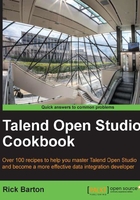
Introduction
This chapter mainly deals with the tMap component which is usually the main processing component at the heart of any Talend transformation job.
The tMap component
The tMap component has extensive transformation capabilities and has thus become the data integration developer's tool of choice. Among the tMap component's capabilities are the ability to:
Flexibility
The tMap component is multipurpose and very flexible and because of this there is often the temptation to do as much as possible in a single tMap component. This isn't recommended, since this can raise the complexity to a level where the code becomes difficult to understand and to maintain. It is recommended that multiple tMap components be used to manage complex transformations, so that the code is more easily understood.
One of the main limitations of tMap is that the output expressions for transformation are limited to just a single line. This can be overcome using code routines that perform complex logic or utilizing tMap variables and the Java ternary operation can be used to perform conditional logic.
All these techniques will be demonstrated in this chapter.